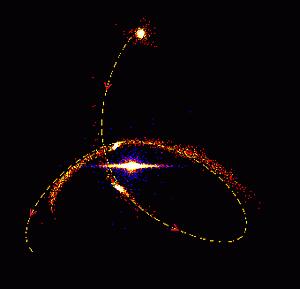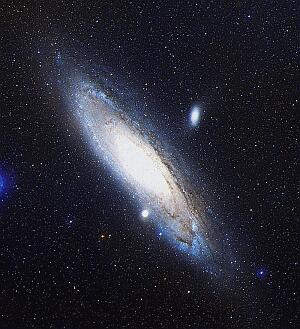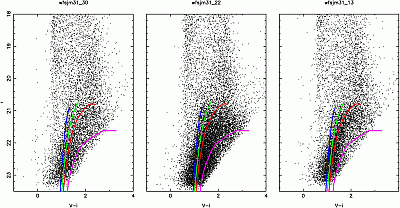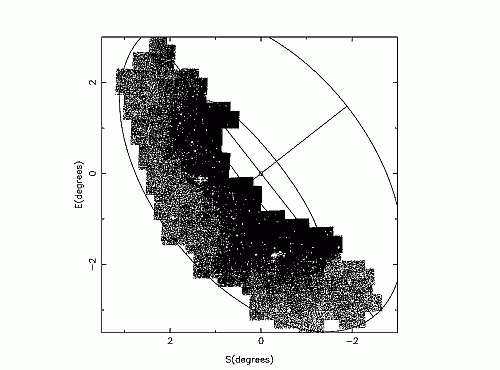THE ING NEWSLETTER No. 5, October 2001
GENERAL SCIENCE TELESCOPES AND INSTRUMENTATION OTHER NEWS FROM ING TELESCOPE TIME
Previous: Contacts Up: Table of Contents Next: The SAURON Survey of Early-Type Galaxies in the Nearby Universe
Article locations: UK Mirror | La Palma server
Other available formats: PDF (893 K)The Andromeda Stream: A Giant Trail of Tidal Stellar Debris in the Halo of M31
M. Irwin (Institute of Astronomy), A. Ferguson (Kapteyn Astronomical Institute), N. Tanvir (Physical Sciences, University of Hertfordshire), R. Ibata (Observatoire de Strasbourg) and G. Lewis (Anglo-Australian Observatory)
Our panoramic wide field imaging survey of M31 using the Wide Field Camera (WFC) on the 2.5-m Isaac Newton Telescope (INT) has unambiguously revealed the presence of a giant stellar stream within M31's halo (Ibata et al., 2001, Nature, 412, 49). The source of the stream is likely to be either, or both, of the peculiar dwarf galaxies M32 and NGC205, close companions of M31, which may have lost a substantial amount of stars, gas and dust due to their tidal interactions with the massive host galaxy. The broad agreement of the metallicity distribution of the stream stars with these two dwarf satellites together with their alignment, physical proximity, and distorted morphological appearance, point to a common origin. The well-known disparity in properties between the Milky Way and M31 stellar haloes would be understandable if the majority of M31's stellar halo arose as relatively recent tidal debris from prolonged bouts of aggressive tidal interaction with its two nearest neighbour satellites. Together with recent observations of tidal debris in the Milky Way halo, these results clearly demonstrate that the epoch of galaxy building still continues, and that substructure in the form of huge, recently-deposited tidal streams, could be a generic feature of large galaxy haloes.
Modern cosmology holds that the development of large complex structures occurs through hierarchical gravitational capture of smaller sub-units. Cosmologists initially had in mind the evolution of galaxy clusters and yet larger scale structures, however, the scale-invariance of the underlying primordial fluctuations implies that similar growth-by-capture should also occur on the scale of individual large galaxies. Until quite recently the two most well-studied nearby large galaxies, M31 and the Milky Way, had stubbornly refused to yield any unambiguous direct evidence of this type of bottom-up growth. Without the corroborating stellar detritus, even the impressive giant arc of gas in the Magellanic Stream can be interpreted as ram pressure stripping by a hot gaseous halo and not as direct tidal accretion.
The discovery of the Sagittarius dwarf (Ibata, Gilmore, & Irwin, 1994, Nature, 370, 194), a satellite galaxy of the Milky Way caught in the act of tidal destruction, irrevocably changed our opinion of the local universe. Further work since then has revealed stellar debris from this system encircling the Galactic Halo, in line with theoretical predictions (Ibata et al., 2001, ApJ, 551, 294). During such a merger, tidal forces shock both the dark matter and the stellar components of the dwarf galaxy, making them gravitationally unbound. The complete destruction of the victim is usually progressive and may take several orbits. However, the tidal debris from the destroyed dwarf galaxy follows a similar orbital path to the progenitor, and tends to be deposited over a broad range in distance in the halo of the larger galaxy (see Figure 1).
The structural and kinematic properties of these streams provide powerful probes of the galactic haloes, especially in regions perpendicular to the disk where the dark matter distribution is essentially unknown. Dynamical mass estimates using such streams provide the key to determining the distribution of the dark matter since the stream stars can be employed as test-particles along orbits through the halo. Evidence for the phase-space clumping of halo stars has even been found in the Solar Neighbourhood, where ~10% of stars may be associated with a single ancient accretion event (Helmi et al., 1999, Nature, 402, 53).
Further evidence of the importance of tidal interactions is provided by the sparse halo globular cluster Palomar 5 which beautifully illustrates both the development of tidal tails in the halo and the morphological evolution of globular cluster systems (Odenkirchen et al., 2001, ApJ, 548, 165). The most compelling example of an external galaxy in which substantial halo sub-structure has been found is NGC5907 (Shang et al., 1998, ApJ, 504, 23), which has a spectacular low surface brightness elliptical loop, 45 kpc in extent, interpreted as the tidal stellar debris of a now defunct dwarf satellite galaxy.
Are these systems particularly unusual or are tidal streams a common feature in galaxies today?
To answer this, in September of last year we trained the INT WFC on the southeastern half of the halo of our nearest large neighbour (D
780kpc), M31, a prime target for both a detailed photometric and kinematic study (see Figure 2).
Figure 1 (left). The progressive destruction of a dwarf galaxy on a plunging orbit around a large host system. Credit Katherine Johnston [ JPEG | TIFF ]. Figure 2 (right). A 3×3 degree view of the Andromeda galaxy with the dwarf companions M32 and NGC205 visible at projected distances of 5 kpc and 9 kpc respectively. Credit Richard Sword [ JPEG | TIFF ]. Previous imaging studies of the M31 halo and outer disk have either sampled only a few discrete locations, or have taken a panoramic, but much shallower view. However, even with a field of view of
35×35 arcmin it took fifty eight adjacent, slightly overlapping, pointings of the INT WFC to tile the southern half of M31's halo out to a projected distance of 50 kpc. By integrating for 900s in V and i' passbands we attained 5-sigma limits of i'=23.5 and V=24.5 and could probe the top 2-3 magnitudes of the Red Giant Branch (RGB) of the M31 halo population. In conjunction with the large area coverage, this allowed us to make an uninterrupted study of the spatial variations in stellar density as a function of both magnitude and colour over a large fraction of the halo.
All of the on-target data plus calibration frames were processed back in Cambridge using the standard INT WFS (Wide Field Survey) data processing pipeline (Irwin & Lewis, 2001, New Astronomy Reviews, 45, 105). The pipeline provides the usual facilities for instrumental signature removal, including in this case defringing of the i'-band data, plus tools for object catalogue creation, astrometric and photometric calibration, morphological classification and cross-matching catalogues from different observations.
Colour-magnitude Diagrams (CMDs) for three halo regions, fields #30, #22, #13, at similar projected distances from the centre of M31, are shown in Figure 3, highlighting the colour diversity, and variation in surface density of the M31 halo population.
Figure 3. Colour-magnitude diagrams for survey fields: a. wfsjm31_30 lying close to the minor axis at a projected distance of 20 kpc at standard coordinates +1.0, -1.1; b. wfsjm31_22 sitting in an apparent halo stream at a similar projected distance to #30 but at standard coordinates +0.4, -2.0; c. wfsjm31_13 lying further round and down from #22 at standard coordinates -0.7, -2.3 (see Figure 4 for a location overview). Note that even though all three fields are at comparable halo distances from the centre of M31, the on-stream field #22 has a far higher density of RGB stars than the minor axis field #30; whilst the RGB of field #13 has a different colour distribution to #22, with an apparent deficit of the more metal rich stars clearly visible in field #22. The fiducial sequences overplotted are Galactic globular cluster sequences with, from the blue end, [Fe/H] = -1.91, -1.29, -0.71, -0.2 respectively. [ GIF | TIFF ]
The overall surface density variation of stellar objects with magnitudes and colours consistent with belonging to an M31 RGB halo population are shown in Figure 4. Simple visual inspection of this figure shows the presence of a stream-like over-density of sources in the halo, close to but distinct from the minor axis of M31. Additional unusual sub-structure is also present but is not so straightforward to interpret. Interestingly, the main stream points directly towards the Andromeda satellites M32 and NGC205, and lies close to the direction of elongation of the tidally distorted outer isophotes of both M32 and NGC205, suggesting a relationship between the Andromeda Stream and these two dwarf galaxies.
Figure 4. Surface density of RGB stars over the southeastern halo of M31. The over-density of stars is seen as a stream extending out of M31 close to, but distinct from, the minor axis. [ GIF | TIFF ] The surface brightness of the stream is about V
30 mag arcsec–2 and by making plausible assumptions to allow for fainter stream stars, the incompleteness of the survey and the uniformity of the stream, we estimate that the absolute magnitude is MV
-14. This luminosity is around a factor of 10 lower than that of M32 and NGC205, consistent with the possibility that the stream represents debris torn from one, or both, of these two dwarf galaxies during a recent encounter with M31.
To understand more fully the nature of the stream further followup observations are planned. Similar panoramic imaging of the northern half of the halo is required, since if M32 and/or NGC205 are the progenitors a similar tidal stream is expected in the northern half of the halo. An extension of the southern halo survey is also needed since the current data do not reach the end of the stream. Finally, since the brightest halo and stream members have magnitudes of around i'=21, kinematic measurements of large numbers of putative stream stars are feasible and will help to probe not only the nature and origin of the stream but also the dark matter distribution in the halo of M31.
But perhaps the final word on this should belong to an observer from a different era.
"While observing the Andromeda Nebula with a fine 18-ft telescope ... I saw another small nebula about one minute in diameter which appeared to throw out two small rays; one to the right and the other to the left."
G-J-H-J-B Le Gentil de la Galazière, October 29, 1749, Remarks on the Nebulous Stars (1759).
Thanks to Michael Drinkwater for drawing our attention to Le Gentil de la Galazière's quotation in Mario Mateo's perceptive Annual Review article.
Email contact: Mike Irwin (mike@ast.cam.ac.uk)
Previous: Contacts at ING Up: Table of Contents Next: The SAURON Survey of Early-Type Galaxies in the Nearby Universe
GENERAL SCIENCE TELESCOPES AND INSTRUMENTATION OTHER NEWS FROM ING TELESCOPE TIME © Isaac Newton Group of Telescopes, La Palma, 2001.



